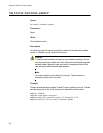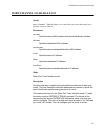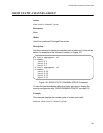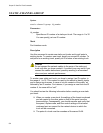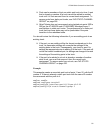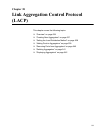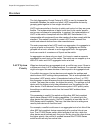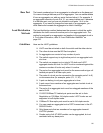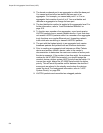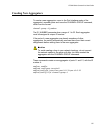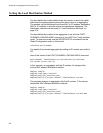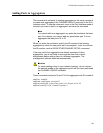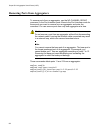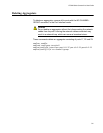
Chapter 38: Link Aggregation Control Protocol (LACP)
534
Overview
The Link Aggregation Control Protocol (LACP) is used to increase the
bandwidth between the switch and other LACP-compatible devices by
grouping ports together to form single virtual links.
LACP trunks are similar in function to static port trunks, but they are more
flexible. The implementations of static trunks tend to be vendor specific
and so may not always be compatible. In contrast, the implementation of
LACP in the switch is compliant with the IEEE 802.3ad standard. It is
interoperable with equipment from other vendors that also comply with the
standard. This makes it possible to create LACP trunks between the
switch and network devices from other manufacturers.
The main component of an LACP trunk is an aggregator. An aggregator is
a group of ports on the switch. The ports of an aggregator are further
grouped into a trunk, referred to as an aggregate trunk. An aggregate
trunk can consist of a maximum of 8 ports on the switch.
An aggregator can have only one trunk. You have to create a separate
aggregator for each trunk on the switch. The switch up can support up to a
total of 32 static and LACP aggregate trunks at a time
LACP System
Priority
When two devices form an aggregate trunk, a conflict may occur if there is
a difference in their LACP implementations. For example, the two devices
might not support the same number of active ports in an aggregate trunk.
If a conflict does occur, the two devices must resolve the problem and
decide whose LACP settings take precedence. This is accomplished with
the system LACP priority value. A hexadecimal value of from 1 to FFFF,
this parameter is used whenever the devices encounter a conflict creating
a trunk. The lower the number, the higher the priority. The settings on the
device with the higher priority take precedence over the settings on the
other device. If both devices have the same system LACP priority value,
the settings on whichever switch has the lowest MAC address takes
precedence.
This parameter is useful if the switch and the other 802.3ad-compliant
device have different LACP trunking capabilities. You should give the
other device the higher priority if its LACP capability is less than the AT-
9000 Series switch capability. That way, the other device’s settings are
used by both devices to form the trunk.
For example, a conflict could occur in an aggregate trunk of six links if the
other 802.3ad-compliant device supported just four active links at one
time. The AT-9000 Series switch would activate all six links, while the
other device would activate only four ports. But by giving the other device
the higher priority, the conflict is avoided because the AT-9000 Series
switch would use only four active links.



